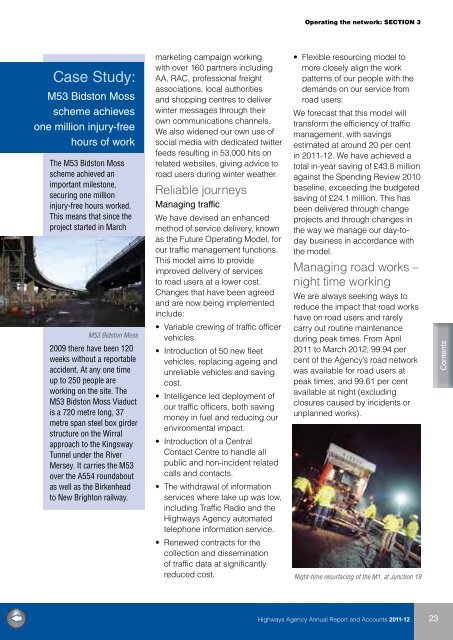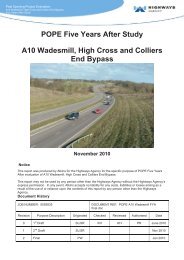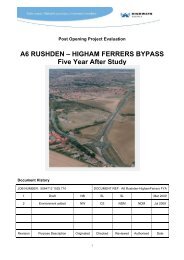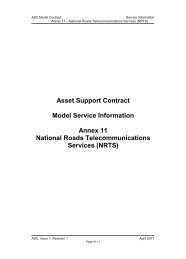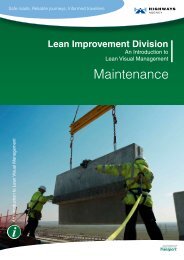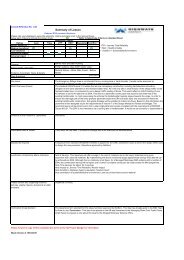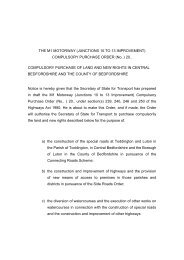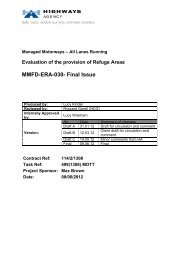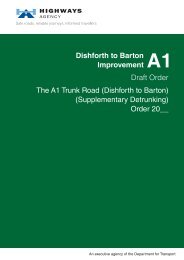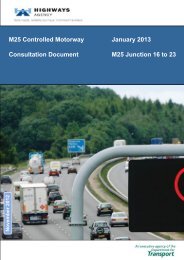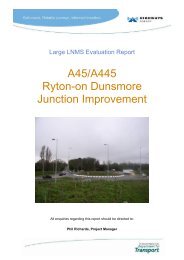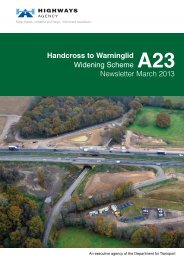Highways Agency Annual Report and Accounts 2011-2012
Highways Agency Annual Report and Accounts 2011-2012
Highways Agency Annual Report and Accounts 2011-2012
Create successful ePaper yourself
Turn your PDF publications into a flip-book with our unique Google optimized e-Paper software.
Operating the network: SECTION 3<br />
Case Study:<br />
M53 Bidston Moss<br />
scheme achieves<br />
one million injury-free<br />
hours of work<br />
The M53 Bidston Moss<br />
scheme achieved an<br />
important milestone,<br />
securing one million<br />
injury-free hours worked.<br />
This means that since the<br />
project started in March<br />
M53 Bidston Moss<br />
2009 there have been 120<br />
weeks without a reportable<br />
accident. At any one time<br />
up to 250 people are<br />
working on the site. The<br />
M53 Bidston Moss Viaduct<br />
is a 720 metre long, 37<br />
metre span steel box girder<br />
structure on the Wirral<br />
approach to the Kingsway<br />
Tunnel under the River<br />
Mersey. It carries the M53<br />
over the A554 roundabout<br />
as well as the Birkenhead<br />
to New Brighton railway.<br />
marketing campaign working<br />
with over 160 partners including<br />
AA, RAC, professional freight<br />
associations, local authorities<br />
<strong>and</strong> shopping centres to deliver<br />
winter messages through their<br />
own communications channels.<br />
We also widened our own use of<br />
social media with dedicated twitter<br />
feeds resulting in 53,000 hits on<br />
related websites, giving advice to<br />
road users during winter weather.<br />
Reliable journeys<br />
Managing traffic<br />
We have devised an enhanced<br />
method of service delivery, known<br />
as the Future Operating Model, for<br />
our traffic management functions.<br />
This model aims to provide<br />
improved delivery of services<br />
to road users at a lower cost.<br />
Changes that have been agreed<br />
<strong>and</strong> are now being implemented<br />
include:<br />
• Variable crewing of traffic officer<br />
vehicles.<br />
• Introduction of 50 new fleet<br />
vehicles, replacing ageing <strong>and</strong><br />
unreliable vehicles <strong>and</strong> saving<br />
cost.<br />
• Intelligence led deployment of<br />
our traffic officers, both saving<br />
money in fuel <strong>and</strong> reducing our<br />
environmental impact.<br />
• Introduction of a Central<br />
Contact Centre to h<strong>and</strong>le all<br />
public <strong>and</strong> non-incident related<br />
calls <strong>and</strong> contacts.<br />
• The withdrawal of information<br />
services where take up was low,<br />
including Traffic Radio <strong>and</strong> the<br />
<strong>Highways</strong> <strong>Agency</strong> automated<br />
telephone information service.<br />
• Renewed contracts for the<br />
collection <strong>and</strong> dissemination<br />
of traffic data at significantly<br />
reduced cost.<br />
• Flexible resourcing model to<br />
more closely align the work<br />
patterns of our people with the<br />
dem<strong>and</strong>s on our service from<br />
road users.<br />
We forecast that this model will<br />
transform the efficiency of traffic<br />
management, with savings<br />
estimated at around 20 per cent<br />
in <strong>2011</strong>-12. We have achieved a<br />
total in-year saving of £43.8 million<br />
against the Spending Review 2010<br />
baseline, exceeding the budgeted<br />
saving of £24.1 million. This has<br />
been delivered through change<br />
projects <strong>and</strong> through changes in<br />
the way we manage our day-today<br />
business in accordance with<br />
the model.<br />
Managing road works –<br />
night time working<br />
We are always seeking ways to<br />
reduce the impact that road works<br />
have on road users <strong>and</strong> rarely<br />
carry out routine maintenance<br />
during peak times. From April<br />
<strong>2011</strong> to March <strong>2012</strong>, 99.94 per<br />
cent of the <strong>Agency</strong>’s road network<br />
was available for road users at<br />
peak times, <strong>and</strong> 99.61 per cent<br />
available at night (excluding<br />
closures caused by incidents or<br />
unplanned works).<br />
Night-time resurfacing of the M1, at Junction 19<br />
<strong>Highways</strong> <strong>Agency</strong> <strong>Annual</strong> <strong>Report</strong> <strong>and</strong> <strong>Accounts</strong> <strong>2011</strong>-12


